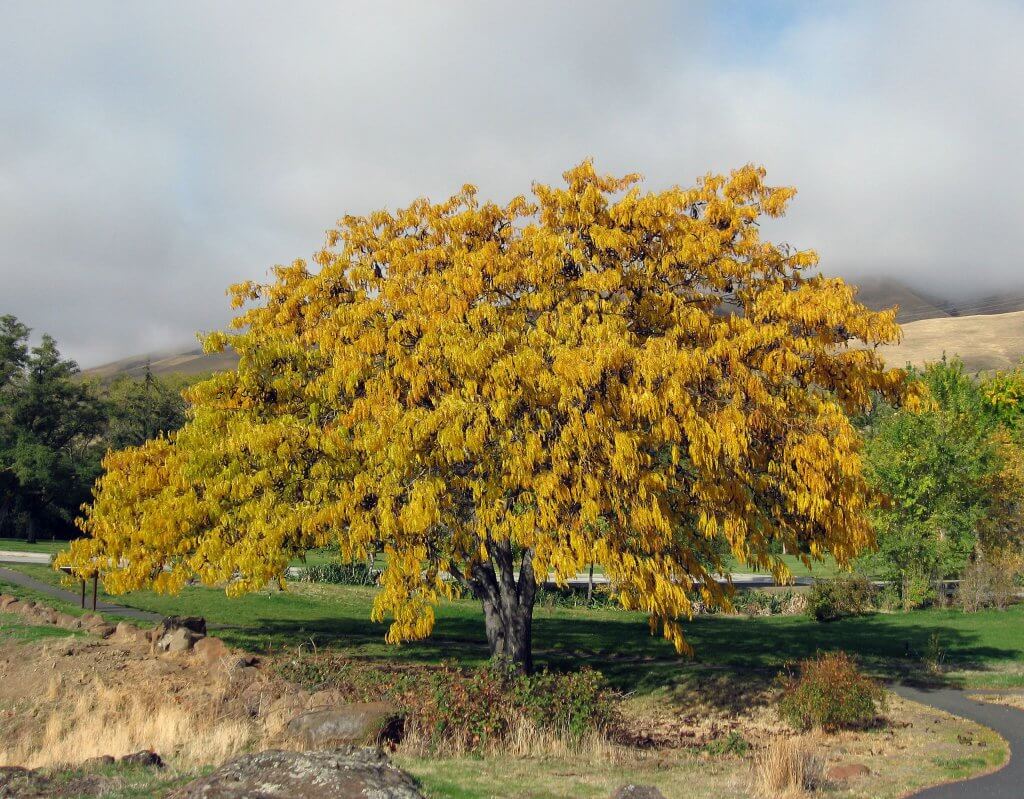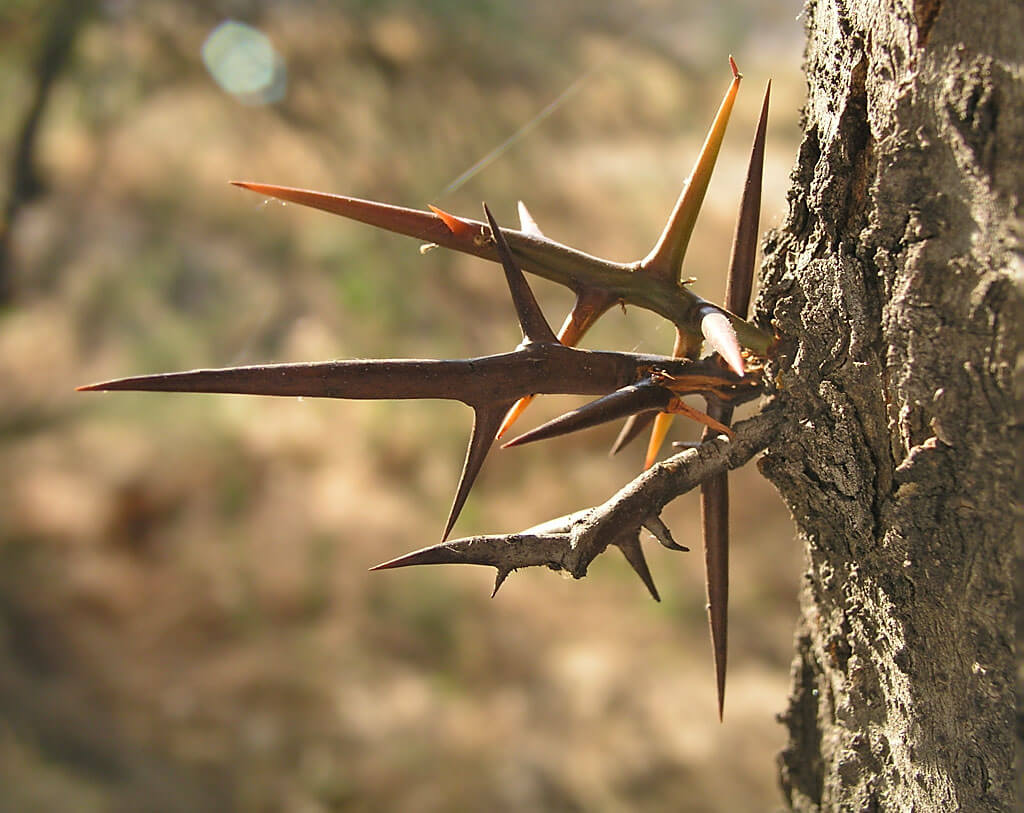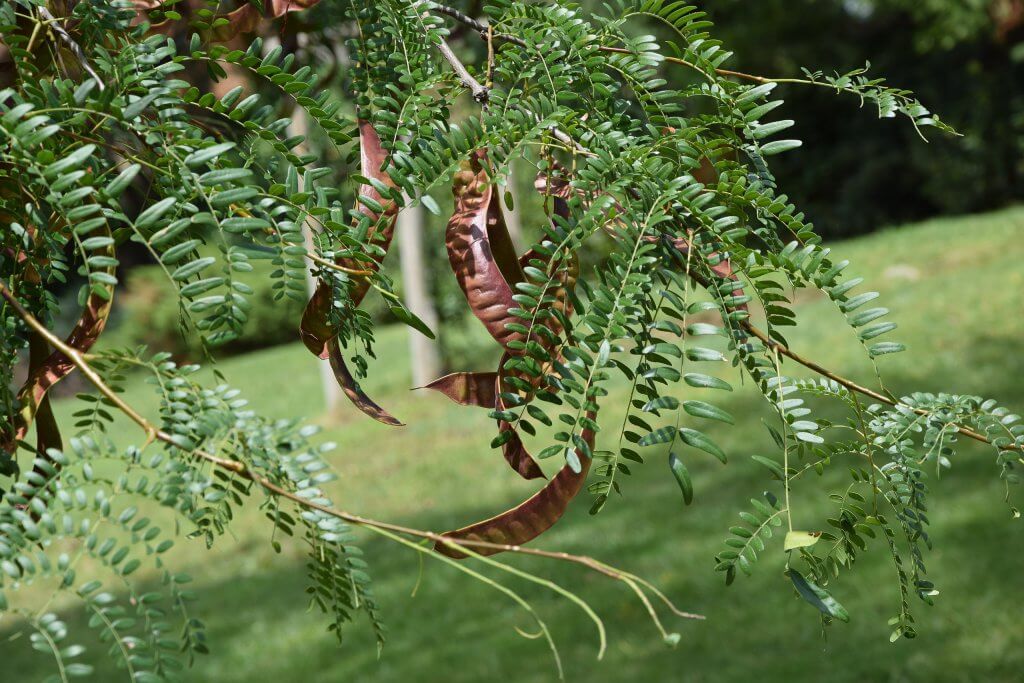Honey Locust (Gleditsia triacanthos), is a deciduous tree and a member of the bean/pea family. It bears long seed filled pods in fall, of which the pulp is sweet and edible. Also commonly known as a thorny locust, this native American tree glows golden in the fall, but bears a menacing array of thorns.
You’ll find it growing in midwestern states, from eastern Texas as far east and north as Pennsylvania. Favoring areas near rivers or the bottom of valley land, it thrives in rich moist soil. It can however adapt well to other soils, and with its frequent seed dispersal through deer and farm animals, can be considered an invasive pest.

Reaching no more than 20m in height, an abundance of pods should still be well within reach on its low spreading branches. Large and intimidating thorns line its trunk and branches, protruding singularly from the tree or forming angular and threatening clusters. The leaves are pinnate compounds, with each oval shaped leaflet measuring up to 2cm long. Clusters of highly scented cream flowers adorn the base of the leaves, developing into the long 20cm seed pods throughout the summer.
Edible parts and other uses
Only the fruits of honey locust are considered edible. The sweet and fleshy pulp of the bean pods can be eaten raw or extracted and used in a variety of ways. From smoothies, to beer. It has a sweet honey like taste, hence its name.
Honey locust was frequently used as a source of food, wood and medicine by Native Americans. The Cherokee were believed to have cultivated honey locusts to create bows, tools and even carved games for children.
Today the wood of honey locust is occasionally used in furniture or agricultural fencing, however it cannot provide yield great enough for commercial production. The strong thorns were interestingly also once used as nails in the construction of barns and other building practices.
Cautions
Honey locust has a toxic lookalike by the name of black locust (Robinia pseudoacacia). The black locust inhabits the same native range, and can be found in similar habitats.
A common distinguishing factor is the number of thorns, as black locust tends to have more subtle and a lower number of thorns. However some ornamental varieties of honey locust have been bred with a reduction in thorns, so careful identification is key. The leaves of black locust also have a much rounder appearance, than the longer oval shaped leaves of honey locust.

The thorns when young are soft and green, however when fully formed, and deep red in color, they can be extremely hazardous. Care should be taken when rummaging amongst leaves and walking between the thorn laden branches.
Foraging
Early autumn is the best time to amble out hunting for the sweet tasting pods. Aim for mixed forests and open plains near rivers or streams. It does not fair well in shade so look for it in areas that receive full or partial sunlight.
The pods begin falling to the ground in fall when they fully ripen. Pods that have not fully ripened will have an astringent taste, so look for freshly fallen pods or ones that loosen easily when plucked from the tree.

Did you know…
The oversized thorns are believed to be an ancient evolutionary characteristic. They formed to help the tree in protecting itself from large grazers that inhabited the earth before the last ice age. From wooly mammoths to mastodons!
Conclusion
A fascinating evolutionary history with a sweet and delicious fruit that has been coveted by mammals since before the last ice age. Today when foraging you will compete only with deers and other small mammals, and not the megafauna from an age long gone.
—————Written by Hannah Sweet
Hannah is a freelance writer and graphic designer from the UK. With a penchant for travelling, photography and all things botanical, she enjoys writing about a wealth of topics and issues, from conservation and slow living, to design and travel. Learn more about her writing and design services at www.sweetmeanders.co
Many of our readers find that subscribing to Eat The Planet is the best way to make sure they don't miss any of our valuable information about wild edibles.
See our privacy policy for more information about ads on this site







2 Responses
I lived in a grove of thorny honeylocust trees, and after years of raking thousands of the big brown pods and pulling the ubiquitous sprouts from the rock-hard brown seeds, I decided to google the edibility of the seeds. Somewhere, I came across mention of cooking them like dry beans (they are legumes, after all). So, I gathered a bunch of the fallen GREEN pods, just as they began to develop brown speckles (like a ripening banana). I tried opening them to remove the beans and found them terribly difficult to deal with. However, breaking the pods in 3-5″ pieces and BLANCHING them for 5-15 minutes (experiment to find out what works best for you), made the pods much easier to open, and even longer cook-times made it easy to squeeze the pods and squirt the beans right out. (I discovered the technique when shelling lots of peas out of their pods – blanch them IN the pods, plunge them in cold water, then squeeze the peas out easily.)
Okay, so now we have our honeylocust beans out of the pods. What do we do with them? We COOK them like any shelled bean – except all those product labels that list “locust bean gum” as an ingredient may have used honeylocust beans as the source of that gum! I cooked my first batch of unblanched beans in a small kettle, seemingly for hours, and they produced so much sticky gum, I think I could have wallpapered a room with it! It sticks to your mouth and is quite unpleasant. They had to be rinsed repeatedly to remove it. The blanched beans didn’t require as much cooking, they freeze beautifully, and I haven’t found them to be as gummy as the unblanched ones. If any are left-over after dining on them, definitely rinse them before reheating.
To me, the boiled green beans, with added salt and butter, taste very similar to green soybeans. I have not attempted to cook the hard, ripe brown beans, which have many of the same characteristics of pea-size gravel – they’re hard as ROCKS. I suspect they would take many hours to cook until edibly tender. Perhaps parboiling first, as with other beans, would shorten the cooking time. I don’t know, or care to find out, as I’ve had all of my honeylocust trees cut down!
I picked up enough pods in about a half hour to stuff three 5-gallon buckets, barely clearing a 20-foot circle in my yard. From those, I blanched, shelled and froze nine pints of lovely green beans. They even bear a slight resemblance to green soybeans. If you try them, definitely blanch them in the pods before attempting to shell them!
I never found any part of the pod sweet to my taste, and the green pods were particularly foul-flavored. I read that the brown dry pods can be ground (after removing the seeds) and used somewhat like brown sugar, and I guess desperation might finally coerce me into trying it that way, but I haven’t been that desperate yet.
Thanks for all the first hand info. The only first hand info I had was that I would split open the pods and scrape out the inner flesh, not the peas just the inner part of the pod. It did seem somewhat sweet. But I’ve tried it a few times it seemed hit or miss whether it was sweet or not. I’m still trying to figure out the details, maybe it depends how ripe the pods are or something like that.